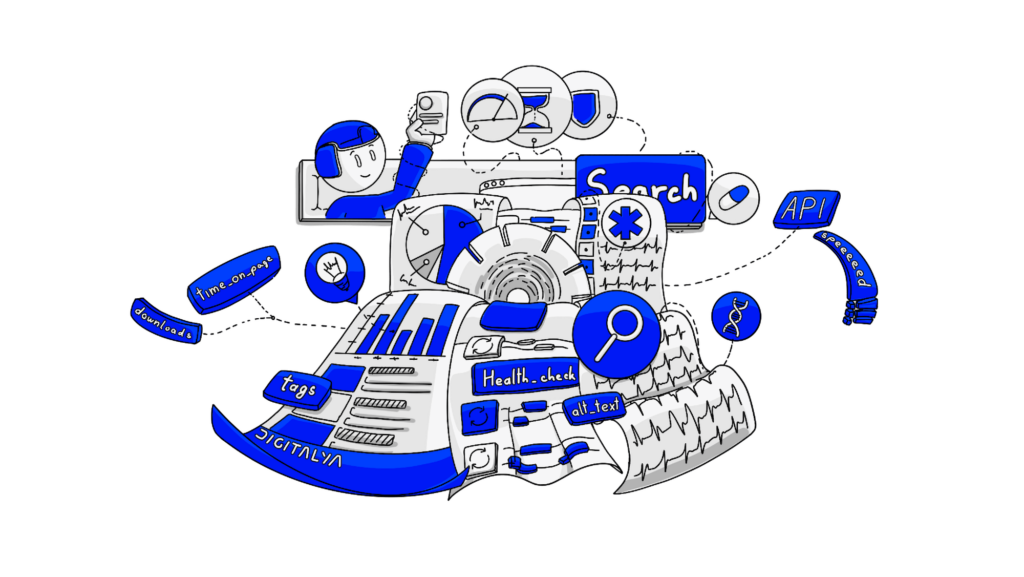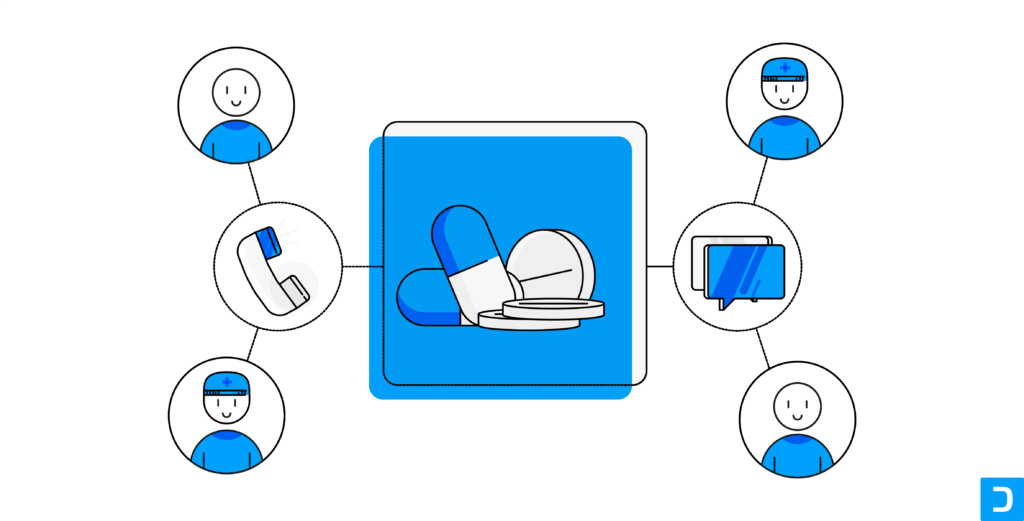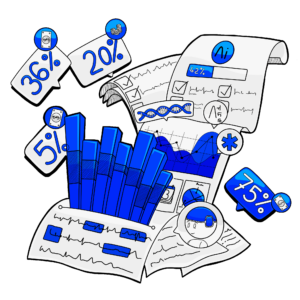There are a number of challenges that pharmaceutical companies must face when customizing global pharma software that we will explore in this article, as well as some insights into how to overcome them.
1. The importance of customizing global pharma software
The pharmaceutical industry is increasingly globalized, with companies operating in multiple countries and regions. To succeed in this environment, pharma companies need to streamline their operations and improve efficiency.
One way to do this is using global pharma software solutions. However, this is not a one-size-fits-all solution. Pharma companies need to customize the software to meet the specific needs of each country and region where they operate.
By doing this, they can improve efficiency, reduce costs, and ensure compliance with all applicable regulations.
1.1 Meeting regional and local regulations
When customizing global software solutions, it’s important to ensure that they comply with all applicable regulations in each country where they will be used. This can be a complex and challenging task since regulations can vary from country to country.
Here are some things to consider:
- Identify the applicable regulations
The first step is to know all of the applicable regulations in each country where the software solution will be used. Asses the software, and any areas of non-compliance should be identified and addressed.
- Customize the software
The software solution may need to be customized to meet the specific requirements of the regulations. This may involve adding new features, modifying existing ones, or removing features that are not allowed by the regulations.
- Validate the software
Once the software has been tailored, it’s important to validate it to ensure that it complies with all applicable regulations. This will involve testing the software with simulated data or conducting real-world testing.
- Monitor the regulations
Regulations can change over time, so it is important to monitor them in each country where the software is used on a regular basis. Any changes should be implemented to ensure compliance.
Pharmaceutical companies can avoid costly fines and penalties by carefully tailoring software solutions to meet the specific needs of each country and region.
1.2 Addressing language and cultural differences
Language and cultural differences are crucial aspects of customizing global pharma software solutions. Failing to consider these differences can lead to miscommunication, reduced user adoption, and even potential compliance issues.
- Effective communication
Language differences can hinder effective communication between users, stakeholders, and the software itself. When the software is unavailable in the local language, users may struggle to understand instructions, input data correctly, or interpret results.
Tailoring the software to support multiple languages ensures that users can work comfortably in their native tongue, minimizing language-related barriers.
- User adoption
Users are more likely to adopt and embrace software that is in their native language. A user interface that aligns with the local culture and language is more intuitive and user-friendly.
This, in turn, enhances user satisfaction and productivity, as users can interact with the software in a way that feels familiar and comfortable.
- Cultural nuances
Cultural differences extend beyond language. They include variations in business practices, etiquette, and user expectations. Customizing pharma software to accommodate cultural nuances ensures that it resonates with local customs and practices.
This is especially important when designing user interfaces, user experience elements, and even marketing materials associated with the software.
- Global collaboration
The pharma industry often involves collaborations and partnerships across borders. Customized software that accommodates multiple languages and cultural considerations facilitates a smoother collaboration with internal stakeholders, reducing misunderstandings and potential conflicts.
- Market perception
How pharma software is presented can influence how it is perceived in the market. Tailored software that respects local cultures and languages is more likely to be considered respectful and considerate.
Conversely, a lack of customization can give the impression of cultural insensitivity or a lack of commitment to the local market.
- Risk mitigation
Ignoring language and cultural differences can lead to misunderstandings, errors, and potential legal issues. Accommodating these differences, pharmaceutical companies can reduce the risk of costly mistakes and damage to their reputation.
1.3 Tailoring workflows to local practices
Tailoring workflows to local practices is an important step. It acknowledges that healthcare practices, regulations, and business processes can vary significantly from one region to another. Here are some vital benefits:
- Regulatory compliance
As mentioned before, different countries have distinct regulatory requirements for pharmaceutical companies. Custom healthcare software must align with local practices to ensure the workflow adheres to specific regulatory standards and reporting obligations.
- Efficiency and productivity
Tailored workflows streamline processes, making them more efficient and productive. By accommodating local practices, the pharmaceutical software can automate tasks, reduce manual interventions, and eliminate unnecessary steps – ultimately saving time and resources.
- Data relevance
Local healthcare practices often require specific data points and metrics to be tracked. Customized workflows can capture and analyze region-specific data, enabling pharma companies to make informed decisions based on the unique needs of the local market.
- Competitive advantage
Tailoring workflows to local practices can provide a competitive edge. Companies that offer software solutions that adapt to the unique needs of the regional and local markets are better positioned to capture market share and expand their customer base.
2. Challenges of customizing
While customizing global pharmaceutical software for regional and local needs is essential for addressing market-specific requirements and achieving optimal performance, it comes with its fair share of challenges.
These challenges range from regulatory hurdles to technical complexities and cultural considerations.
2.1 Technical complexity
Global pharma software is often highly complex and interconnected. Customizing it to meet local needs without compromising its core functionality can be technically challenging. Managing software integrity while making localized modifications requires careful planning and execution
2.2 Cost and resource intensity
Customization projects can be resource-intensive and costly. Pharma companies must allocate significant budgets and manpower to ensure that the customization is carried out efficiently. This can be a deterrent for some organizations, especially smaller ones with limited resources.
2.3 Integration issues
Integrating tailored software solutions with existing systems and processes can be problematic. Customizations might not always fit into the existing technology stack, leading to compatibility issues and disruptions in the workflow.
2.4 Regulatory compliance
Balancing customization with regulatory compliance can be tricky. Customizations must adhere to local regulations while still maintaining alignment with global standards. Ensuring that the software complies with evolving regulations in different regions can be an ongoing challenge.
2.5 Data management and security
Customized software may involve handling sensitive data. Ensuring all information is managed and secured in compliance with local privacy laws while maintaining global data standards can be complex.
Despite these challenges, tailoring global pharmaceutical software for regional and local needs is still of undeniable importance.
3. Strategies for successful customization
Achieving successful customization of global pharmaceutical software for regional and local needs requires a well-thought-out strategy. Here are some key points:
3.1 Cross-functional collaboration
Collaboration between global and regional teams, software developers, regulatory experts, healthcare practitioners, and end-users is essential. Each group brings unique insights and expertise to the customization process.
Establish clear lines of communication between teams and hold regular meetings to discuss progress, challenges, and feedback. Ensure that all stakeholders have a voice in the customization process.
3.2 Flexible software architecture
Choose software solutions with a modular architecture that allows for easier customization. This enables specific components or modules to be customized without affecting the core functionality.
Using APIs to integrate customized components seamlessly into the existing software infrastructure. APIs provide a standardized way to extend and enhance software functionality.
3.3 Documentation and training
Develop region-specific training programs that cover software usage, regional workflows, regulations, and cultural considerations. Tailored training ensures that users are well-prepared to work with the custom software solution.
Additionally, provide user manuals and resources in the local language, offering clear instructions and guidance for users who may not be proficient in the global language of the company.
3.4 Quality control and validation
Implement robust validation processes to ensure that the software solution meets regulatory requirements and quality standards. Validation protocols should be adapted to address region-specific needs.
Conduct regular audits of the customized software to verify ongoing compliance, data accuracy, and performance. Address any issues promptly to maintain software integrity.
3.5 Change management
Develop a comprehensive change management plan to facilitate the transition to customized software. This plan should include communication strategies, user training, and methods for addressing user concerns and resistance.
Establish feedback mechanisms to collect input from users and stakeholders. Act on feedback to continuously improve the customization and address any emerging issues.
3.6 Scalability and future-proofing
Choose software solutions and customization strategies that are scalable and adaptable to future needs. Ensure that customization efforts can accommodate the expansion into new regions or changes in regulatory environments.
Keep abreast of industry trends, emerging technologies, and regulatory updates. Proactively adjust customization strategies to stay ahead of changes in the pharmaceutical landscape.
3.7 Vendor selection and partnerships
If outsourcing customization, select custom software development vendors with a strong track record in pharmaceutical software solutions and a deep understanding of regional requirements.
Forge strategic partnerships with software vendors and service providers to access ongoing support, updates, and expertise in customization and compliance.
3.8 Data Security and Privacy
Implement robust data encryption and security measures to protect sensitive patient and clinical data in accordance with regional data privacy laws.
Create audit trails and access logs to maintain transparency and accountability in data handling, which is essential for regulatory compliance.
3.9 Continuous Monitoring and Improvement
Define KPIs to measure the success and effectiveness of customization efforts. Regularly monitor and analyze these KPIs to identify areas for improvement.
Establish a feedback loop with users and stakeholders to gather insights on the usability and effectiveness of the customized software. Use this feedback to drive ongoing improvements.
3.10 Regulatory Updates and Compliance Monitoring
Stay vigilant about changes in regulatory requirements across regions. Establish processes for monitoring regulatory updates and promptly adapting customization to maintain compliance.
Implement a robust compliance tracking system to ensure the software remains compliant with evolving market regulations.
By implementing these strategies, pharmaceutical companies can effectively navigate the complexities of customizing global software for regional and local needs. Customization enables compliance, efficiency, and user satisfaction, supporting the company’s success in diverse markets.
4. Technological solutions
Technological solutions are pivotal in customizing global pharmaceutical software for regional and local needs. These solutions enable companies to adapt software efficiently while maintaining core functionalities and compliance. Here are some technological strategies and solutions to consider:
- Microservices – Adopt a microservices architecture, where the software comprises small, independent services that can be customized or replaced without affecting the entire system. This approach allows for granular customization.
- Component-Based Development – Build the software using a component-based approach, where different parts of the software are encapsulated as reusable components. This makes it easier to customize specific components to meet regional needs.
- API Integration – Leverage APIs to facilitate the integration of customized components or third-party solutions into the existing software infrastructure. APIs provide a standardized way to extend and enhance software functionality.
- API Management Platforms – Consider using API management platforms that offer tools for designing, deploying, and monitoring APIs. These platforms help manage the integration of customized modules.
- Parameterization – Implement configurable settings within the software to allow administrators to adjust various parameters. This enables the customization of specific software features without requiring extensive coding or development.
- User-Defined Fields – Incorporate user-defined fields and forms within the software to allow users to adapt data capture and reporting to their local needs. Users can configure these fields to align with regional requirements.
- Localization Software – Utilize localization software and tools that facilitate the translation of user interfaces, labels, and content into multiple languages. This ensures that the software is accessible to users in their native language.
- Content Management Systems (CMS) – Implement CMS solutions that allow for the easy management and customization of content, such as product descriptions and documentation, for different regions.
- Data Integration Platforms – Invest in data integration platforms that can harmonize and consolidate data from various sources and formats. This enables the analysis of region-specific data and the creation of customized reports.
- Business Intelligence (BI) Tools – Utilize BI tools to extract actionable insights from region-specific data. These tools can help identify trends, compliance issues, and opportunities for process optimization.
- Predictive Analytics – Implementing AI and ML algorithms to analyze data and predict trends can be particularly valuable in understanding regional market dynamics and optimizing supply chain operations.
- Chatbots and Virtual Assistants – Deploy AI-powered chatbots or virtual assistants that can interact with users in multiple languages and provide region-specific information and support.
- Scalable Infrastructure – Utilize scalability cloud computing platforms, enabling customization efforts to expand seamlessly as the company enters new markets or experiences growth.
- Global Accessibility – Cloud-based solutions provide global accessibility, allowing users in different regions to access the software from anywhere with an internet connection.
- Data Encryption – Ensure that data is encrypted both in transit and at rest to protect sensitive patient and clinical information in compliance with regional data privacy regulations.
- Access Controls – Implement robust access control mechanisms to restrict data access based on user roles and regional requirements, minimizing the risk of data breaches.
- Regulatory Compliance Software – Invest in regulatory compliance software solutions that assist in tracking and adhering to region-specific regulations, reporting requirements, and documentation standards.
- Validation Tools – Utilize validation tools that automate testing and validation processes, ensuring customized software complies with regional and global standards.
By incorporating these technological solutions and strategies, pharmaceutical companies can effectively customize their global software to meet the unique requirements of regional and local markets. These solutions enhance flexibility, compliance, and user satisfaction, ultimately contributing to the company’s success in diverse markets.
5. Conclusion
In a world where global collaboration and localized excellence are the hallmarks of success, customization challenges are ultimately the stepping stones toward a brighter future for the pharmaceutical industry. By embracing these challenges with diligence, innovation, and a commitment to excellence, pharmaceutical companies can transform the complexities of customization into opportunities that enhance healthcare outcomes and advance the industry as a whole.







